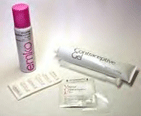 Although, spermicides are cheap and widely used they also have a few side effects that should be explained. Spermicidal compounds, containing nonoxynol-9 or others, were found to cause irritation of vagina in many women. In addition, spermicides may cause allergic reactions. The main reason for that is nonoxynol-9. Spermicides may irritate not only the vagina but also the penis. They may cause ulcerations of genital tract of both males and females. When used in anal sex spermicidal substances cause sores of rectal lining. This results in enhanced risk of sexually transmitted diseases. In addition, spermicides have the ability in changing the pH of the vagina which may cause yeast infections. They were also found to predispose urinary infections or inflammation in women.
Although, spermicides are cheap and widely used they also have a few side effects that should be explained. Spermicidal compounds, containing nonoxynol-9 or others, were found to cause irritation of vagina in many women. In addition, spermicides may cause allergic reactions. The main reason for that is nonoxynol-9. Spermicides may irritate not only the vagina but also the penis. They may cause ulcerations of genital tract of both males and females. When used in anal sex spermicidal substances cause sores of rectal lining. This results in enhanced risk of sexually transmitted diseases. In addition, spermicides have the ability in changing the pH of the vagina which may cause yeast infections. They were also found to predispose urinary infections or inflammation in women.
The possibility for side effects of spermicides increases with the increased amount of spermicide used. Some doctors recommend using any type of spermicidal methods of birth control not more than three times a month. Therefore this type of birth control is mainly chosen by people, who have infrequent sexual life.
There are no restrictions for the use of spermicides. Breastfeeding women may use this method, since it does not have any effect on a baby. Women, who do not wish to use hormonal contraception, also may choose spermicidal products for birth control. Women may use these products during all their reproductive years and become fertile immediately upon discontinuation of use.
However, men and women who develop allergy after use of spermicides should choose a more appropriate method for birth control. Women, who have the history of vaginal sores, urinary infections or inflammation, should be recommended another form of contraception. And finally, people who have multiple sexual partners and increased risk for STD’s are strictly not recommended using spermicides since they may increase the chance of getting sexually transmitted diseases.
In the early 80’s spermicides were thought to protect against some sexually transmitted diseases or infections and even HIV. This was due to investigations which showed that nonoxynol-9, a chemical substance found in many spermicides, was able to destroy Chlamydia, trichomoniasis, gonorrhea and HIV. However, later studies on humans in practice revealed that spermicides not only do not add any protection against sexually transmitted diseases but may even increase the risk for STD’s and HIV. Spermicides may cause ulcers or lesions of genital tract and anus and this increases the possibility for microorganisms to enter the human body. Therefore, people with increased risk of STD’s are no longer recommended using spermicides for birth control. Also, male condoms prelubricated with spermicides were found to have no additional protection nor against pregnancy neither against STD’s and should no longer be recommended. If you choose spermicidal products for birth control do not forget to use a male condom for protection against sexually transmitted diseases.
 They are chemical compounds, mostly containing nonoxynol-9, octoxynol-9, menfegol or benzalkonium chloride. They protect against pregnancy when inserted into vagina in a right way and time. The effectiveness of
They are chemical compounds, mostly containing nonoxynol-9, octoxynol-9, menfegol or benzalkonium chloride. They protect against pregnancy when inserted into vagina in a right way and time. The effectiveness of